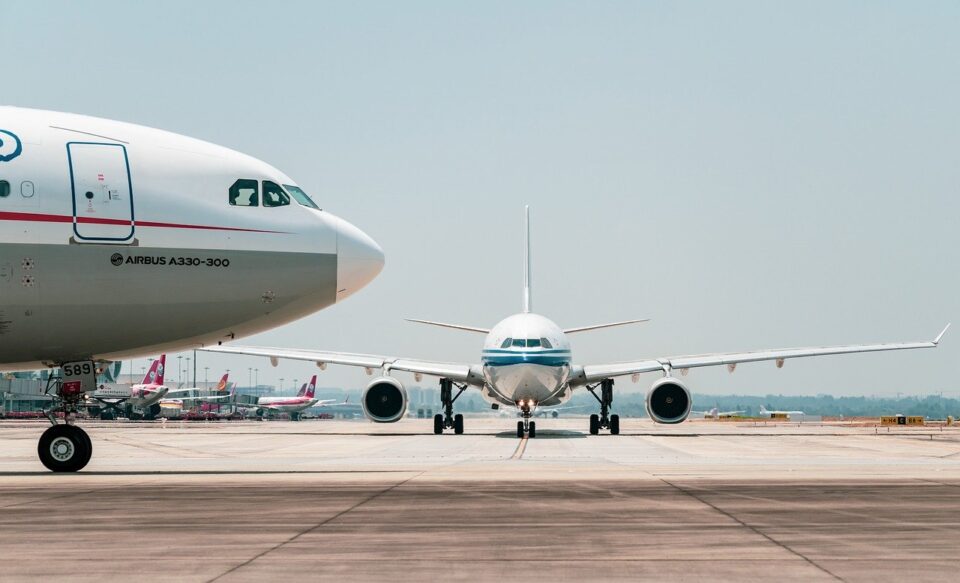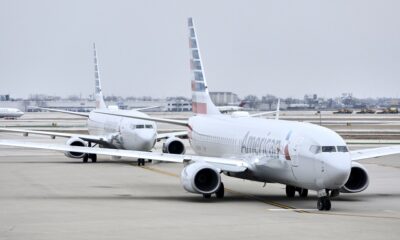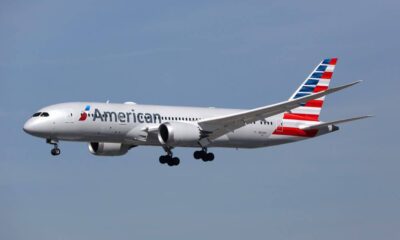Airlines
Close call as two packed planes almost collide on runway at New York’s JFK airport

According to radar data and recordings of those conversations, a close call at Kennedy International Airport on Friday night in which an American Airlines plane nearly collided with an approaching Delta Air Lines plane happened when the American Airlines pilots misunderstood instructions from air traffic controllers.
Flight 1943 of Delta, which was bound for the Dominican Republic, was forced to abort takeoff. All 145 of its passengers were safe.
According to Ross Feinstein, a former spokesman for both American Airlines and the Transportation Security Administration who claimed to have reviewed publicly available radar and recordings, the American Airlines flight, Flight 106, with 137 passengers on board, was travelling along a taxiway at around 8:45 p.m. when it came close to a location where two runways cross perpendicularly. Runway 4 Left, which intersects with Runway 31 Left, is where the Delta aircraft was ready to take off.
The American Boeing 777 is heard being instructed by an air traffic controller to “cross Runway 31 Left,” which calls for it to make a right turn before turning back to line up for departure on Runway 4 Left behind the Delta aircraft.
The Boeing 737-powered Delta aircraft receives clearance to take off from another air traffic controller. “Cleared for takeoff, Runway 4 Left, Delta 1943,” the pilot of the Delta says.
However, as the Delta plane started to take off, the American flight jogged left, then right, and continued straight across Runway 4 Left, as shown by the radar, according to Mr. Feinstein. This prevented the American flight from turning right to cross Runway 31 Left.
An air traffic controller can be heard using a four-letter word in an audio clip. Hold position!, one controller commands the American aircraft, and “Delta 1943, cancel takeoff clearance,” another controller commands twice and fast.
JFK Airport New York – Friday the 13th, 2023. American Airlines Boeing 777 (AAL106) going to London crosses the wrong runway while taxiing while a Delta Airlines Boeing 737 (DAL1943) is departing for Santo Domingo on the same runway stopping their takeoff avoiding a disaster. ? pic.twitter.com/vhzXI8zD7M
— Thenewarea51 (@thenewarea51) January 15, 2023
In a statement, Delta claimed that it “will collaborate with and support aviation authorities on a thorough investigation of flight 1943, which involved a successful aborted takeoff at New York-JFK on January 13. We sincerely regret that our customers’ travels were a hassle and were delayed.”
As said in a statement released on Monday, “Our main focus is the safety of both our clients and our staff. In addition to collaborating with the National Transportation Safety Board in its investigation, we are carrying out a thorough internal inquiry.”

Airlines
Air India’s last VVIP Boeing 747 now found a new home in USA

In a symbolic transition marking the end of a storied chapter in aviation history, Air India bid farewell to its last remaining Boeing 747-400 jumbo jetliners, once revered for ferrying dignitaries including prime ministers, presidents, and vice presidents.
The sale of these iconic aircraft to AerSale, a company based in the United States, signals the closure of a remarkable era for the airline.
The decision to part ways with the Boeing 747s was driven by practical considerations. Tata Group, the new custodian of airindia flights, deemed these majestic planes uneconomical to operate in today’s aviation landscape. As such, out of the four sold, two will be repurposed into freighters, while the remaining pair will be meticulously disassembled to harness their valuable parts.
The transaction, orchestrated by Mumbai-based Vman Aviation Services, underscores the strategic shift in Air India’s fleet management strategy under its new ownership. Tata Group’s decision to divest from the 747s reflects a commitment to optimizing operational efficiency and aligning with contemporary industry standards.
Skytech-AIC, a UK-based remarketing firm engaged by Tata Group, facilitated the sale of these iconic aircraft, marking the conclusion of their illustrious service with Air India. The airline’s last flight featuring the Boeing 747 took to the skies between Delhi and Mumbai in March 2021, encapsulating decades of distinguished service and indelible memories.
The allure of used aircraft parts continues to resonate across the aviation sector, offering operators a cost-effective alternative without compromising on quality or performance. The transfer of these aircraft to AerSale not only ensures their continued utility but also underscores the enduring legacy of Air India’s fleet.
Airlines
A software error caused grounding the entire airline fleet

On Wednesday, the U.S. Federal Aviation Administration (FAA) issued a ground stop advisory for all Alaska Airlines and subcarrier flights due to a software issue, disrupting travel plans for passengers.
The FAA directive, which prohibited the departure of Alaska Airlines mainline and subcarrier flights, was implemented as a precautionary measure following the detection of the software problem. The ground stop was initiated after Alaska Airlines encountered difficulties during a system upgrade related to the calculation of weight and balance for their flights.
As a result, the airline opted for a temporary suspension of all its operations to address the issue and ensure passenger safety. Alaska Airlines promptly issued a statement acknowledging the incident and expressing their commitment to resolving the matter swiftly. “This morning we experienced an issue while performing an upgrade to the system that calculates our weight and balance.
Out of an abundance of caution, we requested a ground stop for all Alaska and Horizon flights, which was instituted at approximately 7:30 a.m. PT,” the statement read. Passengers affected by the disruption voiced their concerns on social media platforms, prompting Alaska Airlines to reassure them of their efforts to minimize the inconvenience and expedite the resumption of flights.
Following approximately an hour-long interruption, the FAA lifted the ground stop order, allowing Alaska Airlines and its subcarriers to resume normal operations. However, it was clarified that SkyWest, which provides regional service for Alaska Airlines and other carriers, was exempt from the ground stop and continued its flights unaffected.
Aerospace
Which is bigger 777x or 787 aircraft ?

The 777X is a new series of the Boeing 777 family and is designed to be larger and more efficient than its predecessor. It features two variants: the 777-8 and the 777-9, being the larger of the two.
The Boeing 777X emerges as the larger sibling within the Boeing family, representing a significant leap forward in both size and efficiency. Comprising two variants, the 777-8 and the 777-9, the latter takes the crown as the larger of the two. With its expansive fuselage and impressive wingspan, the 777X is tailored for long-range journeys and boasts a substantial passenger capacity.
On the other hand, the Boeing 787, affectionately known as the Dreamliner, occupies a niche in the market as a smaller yet formidable aircraft designed for medium to long-range flights. Its distinguishing feature lies in its composite fuselage, a technological marvel that renders it lighter and more fuel-efficient compared to conventional aluminum counterparts. The Boeing 777X is larger than the Boeing 787 aircraft.
When it comes to passenger capacity, the 777-9 reigns supreme, typically accommodating a sizeable contingent of 400-425 passengers in its standard configuration. In contrast, the 787, with its more modest dimensions, typically carries between 240-290 passengers, depending on the variant and layout.
One of the remarkable innovations introduced with the 777X is its folding wingtips, a feature designed to address the logistical challenges of accommodating such a large aircraft in conventional airport gates. These folding wingtips enable the 777X to retract its wings, allowing it to fit into gates designed for smaller aircraft while still reaping the benefits of an extended wingspan during flight, thereby enhancing fuel efficiency and operational flexibility


























